Marketing Report: Selling, Environment, Buying Process, STP, Planning
VerifiedAdded on 2023/01/11
|10
|2777
|71
Report
AI Summary
This report provides a comprehensive overview of foundational marketing concepts. It begins by differentiating between selling and marketing orientations, illustrating the differences with examples. The report then defines and contrasts the micro and macro external environments, highlighting their impact on business operations. A detailed explanation of the five stages of the consumer buying decision process is included, providing valuable insights into consumer behavior. The relationship between segmentation, targeting, and positioning (STP) is examined within the context of the fashion industry, specifically Burberry. Finally, the report emphasizes the benefits of a formal marketing planning process, underscoring its importance for business success. The report utilizes academic sources to support its analysis and conclusions.
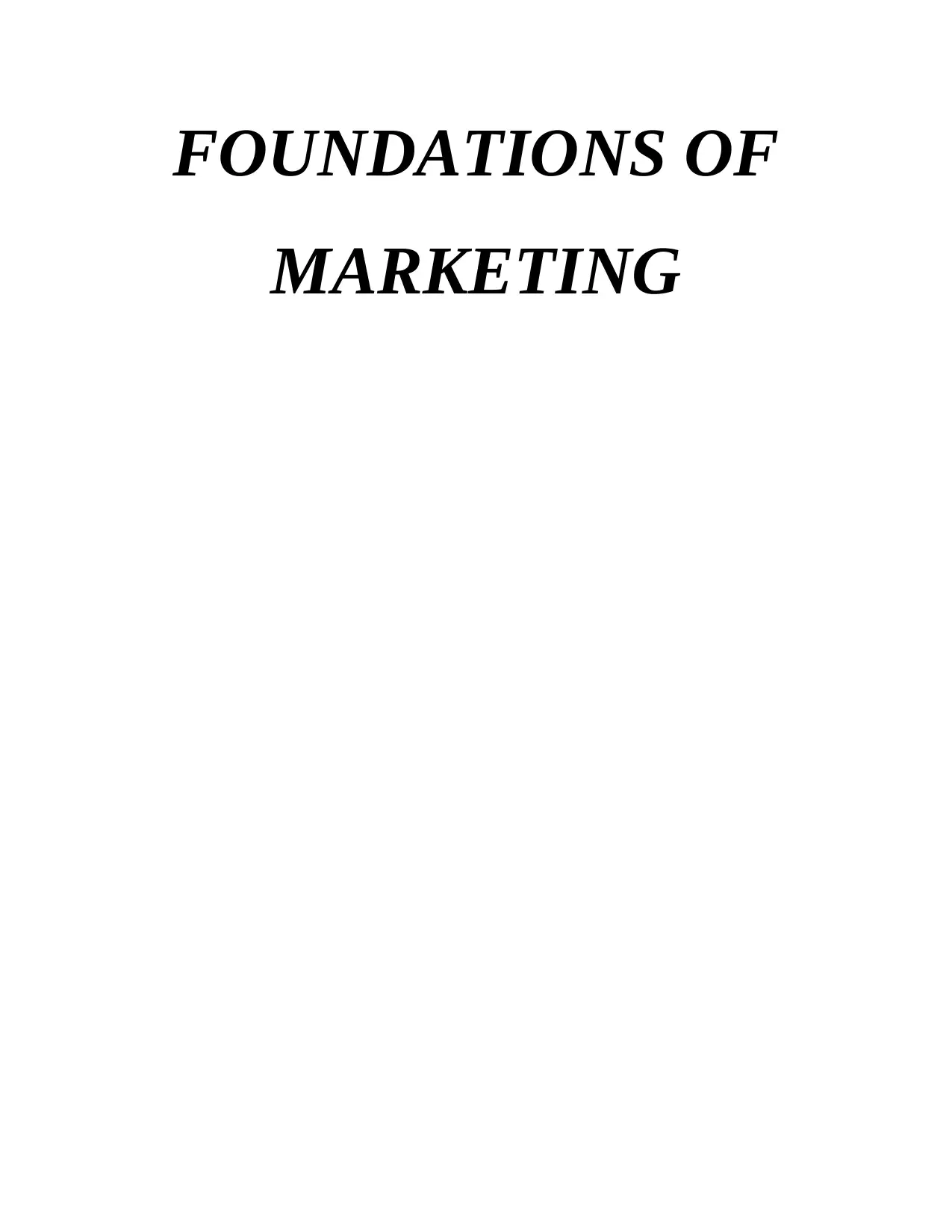
FOUNDATIONS OF
MARKETING
MARKETING
Paraphrase This Document
Need a fresh take? Get an instant paraphrase of this document with our AI Paraphraser
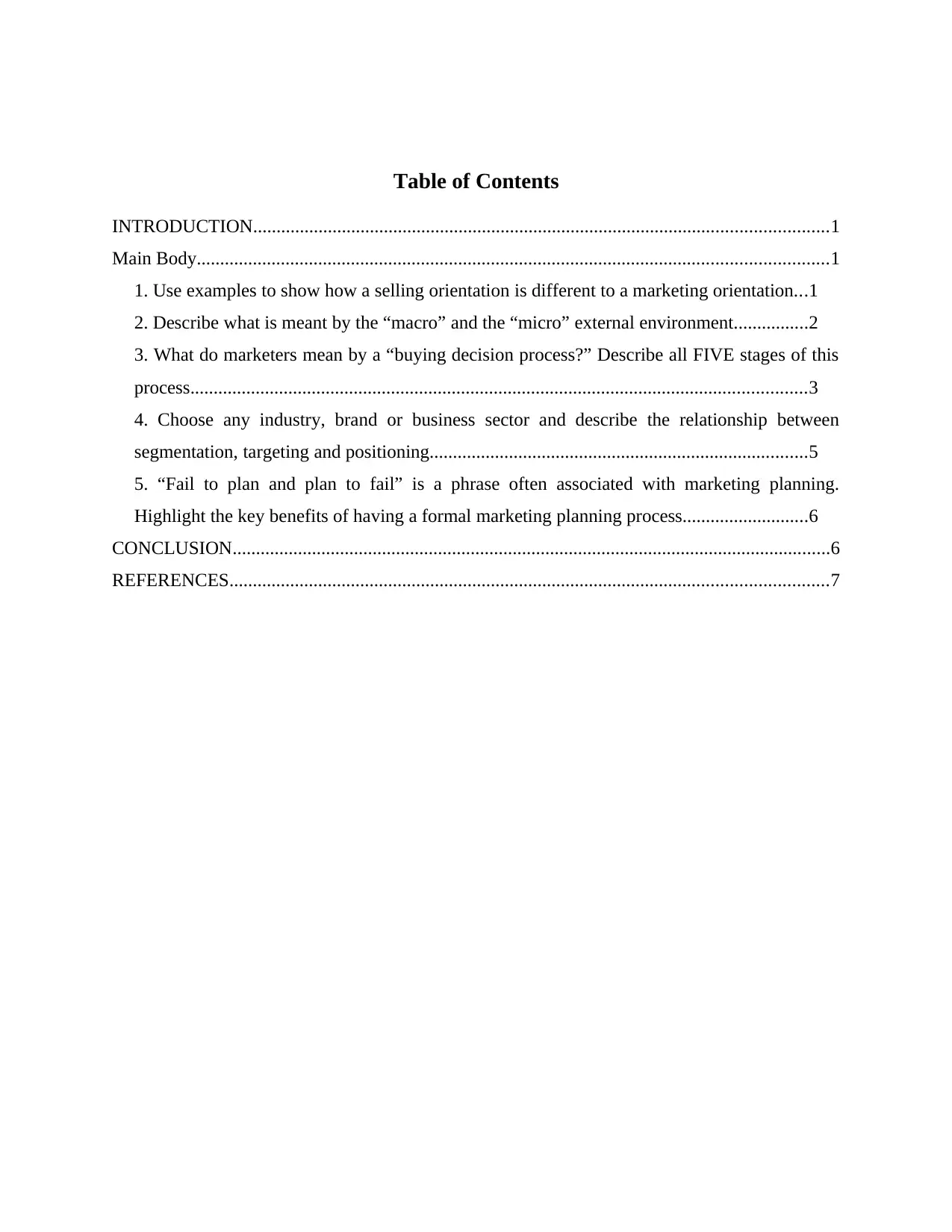
Table of Contents
INTRODUCTION...........................................................................................................................1
Main Body.......................................................................................................................................1
1. Use examples to show how a selling orientation is different to a marketing orientation...1
2. Describe what is meant by the “macro” and the “micro” external environment................2
3. What do marketers mean by a “buying decision process?” Describe all FIVE stages of this
process....................................................................................................................................3
4. Choose any industry, brand or business sector and describe the relationship between
segmentation, targeting and positioning.................................................................................5
5. “Fail to plan and plan to fail” is a phrase often associated with marketing planning.
Highlight the key benefits of having a formal marketing planning process...........................6
CONCLUSION................................................................................................................................6
REFERENCES................................................................................................................................7
INTRODUCTION...........................................................................................................................1
Main Body.......................................................................................................................................1
1. Use examples to show how a selling orientation is different to a marketing orientation...1
2. Describe what is meant by the “macro” and the “micro” external environment................2
3. What do marketers mean by a “buying decision process?” Describe all FIVE stages of this
process....................................................................................................................................3
4. Choose any industry, brand or business sector and describe the relationship between
segmentation, targeting and positioning.................................................................................5
5. “Fail to plan and plan to fail” is a phrase often associated with marketing planning.
Highlight the key benefits of having a formal marketing planning process...........................6
CONCLUSION................................................................................................................................6
REFERENCES................................................................................................................................7
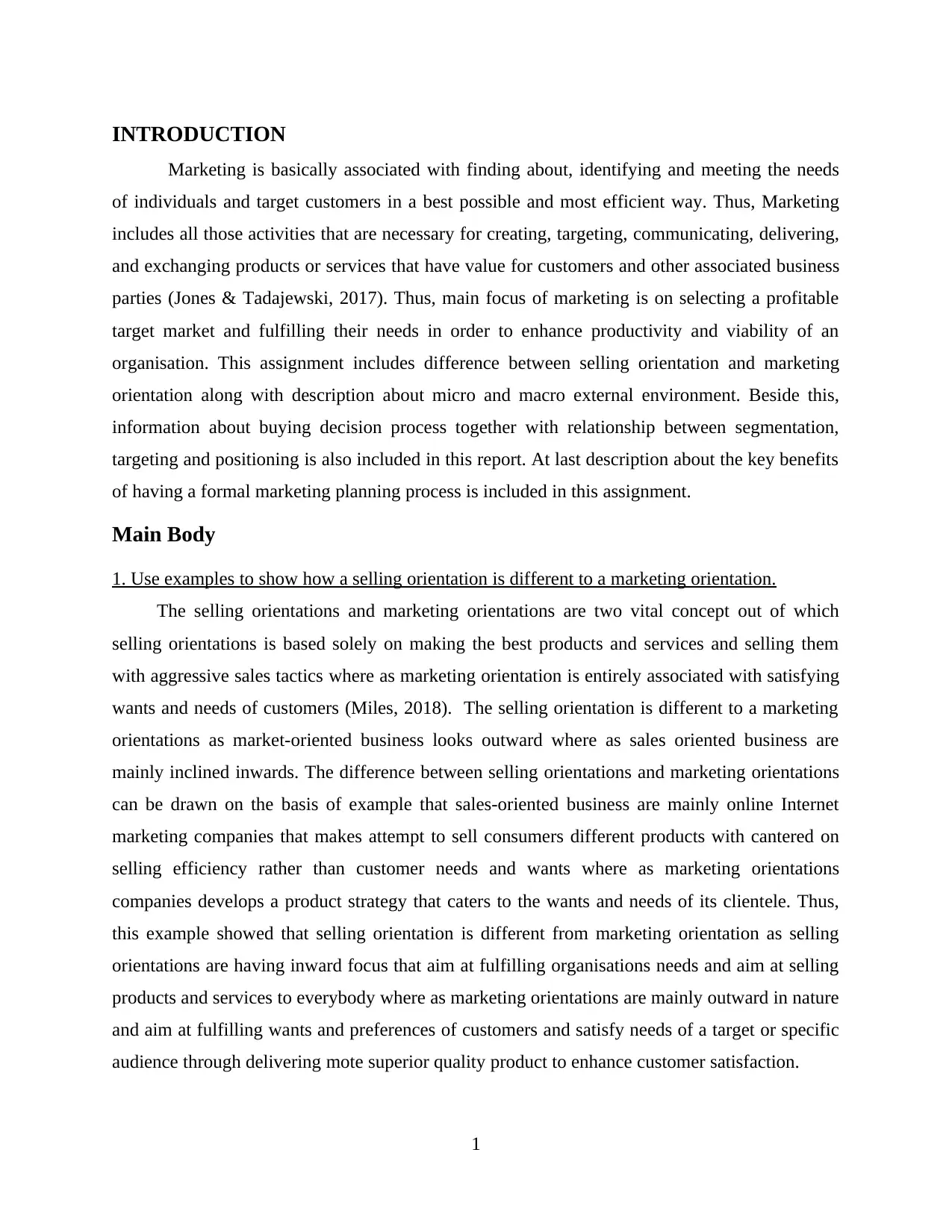
INTRODUCTION
Marketing is basically associated with finding about, identifying and meeting the needs
of individuals and target customers in a best possible and most efficient way. Thus, Marketing
includes all those activities that are necessary for creating, targeting, communicating, delivering,
and exchanging products or services that have value for customers and other associated business
parties (Jones & Tadajewski, 2017). Thus, main focus of marketing is on selecting a profitable
target market and fulfilling their needs in order to enhance productivity and viability of an
organisation. This assignment includes difference between selling orientation and marketing
orientation along with description about micro and macro external environment. Beside this,
information about buying decision process together with relationship between segmentation,
targeting and positioning is also included in this report. At last description about the key benefits
of having a formal marketing planning process is included in this assignment.
Main Body
1. Use examples to show how a selling orientation is different to a marketing orientation.
The selling orientations and marketing orientations are two vital concept out of which
selling orientations is based solely on making the best products and services and selling them
with aggressive sales tactics where as marketing orientation is entirely associated with satisfying
wants and needs of customers (Miles, 2018). The selling orientation is different to a marketing
orientations as market-oriented business looks outward where as sales oriented business are
mainly inclined inwards. The difference between selling orientations and marketing orientations
can be drawn on the basis of example that sales-oriented business are mainly online Internet
marketing companies that makes attempt to sell consumers different products with cantered on
selling efficiency rather than customer needs and wants where as marketing orientations
companies develops a product strategy that caters to the wants and needs of its clientele. Thus,
this example showed that selling orientation is different from marketing orientation as selling
orientations are having inward focus that aim at fulfilling organisations needs and aim at selling
products and services to everybody where as marketing orientations are mainly outward in nature
and aim at fulfilling wants and preferences of customers and satisfy needs of a target or specific
audience through delivering mote superior quality product to enhance customer satisfaction.
1
Marketing is basically associated with finding about, identifying and meeting the needs
of individuals and target customers in a best possible and most efficient way. Thus, Marketing
includes all those activities that are necessary for creating, targeting, communicating, delivering,
and exchanging products or services that have value for customers and other associated business
parties (Jones & Tadajewski, 2017). Thus, main focus of marketing is on selecting a profitable
target market and fulfilling their needs in order to enhance productivity and viability of an
organisation. This assignment includes difference between selling orientation and marketing
orientation along with description about micro and macro external environment. Beside this,
information about buying decision process together with relationship between segmentation,
targeting and positioning is also included in this report. At last description about the key benefits
of having a formal marketing planning process is included in this assignment.
Main Body
1. Use examples to show how a selling orientation is different to a marketing orientation.
The selling orientations and marketing orientations are two vital concept out of which
selling orientations is based solely on making the best products and services and selling them
with aggressive sales tactics where as marketing orientation is entirely associated with satisfying
wants and needs of customers (Miles, 2018). The selling orientation is different to a marketing
orientations as market-oriented business looks outward where as sales oriented business are
mainly inclined inwards. The difference between selling orientations and marketing orientations
can be drawn on the basis of example that sales-oriented business are mainly online Internet
marketing companies that makes attempt to sell consumers different products with cantered on
selling efficiency rather than customer needs and wants where as marketing orientations
companies develops a product strategy that caters to the wants and needs of its clientele. Thus,
this example showed that selling orientation is different from marketing orientation as selling
orientations are having inward focus that aim at fulfilling organisations needs and aim at selling
products and services to everybody where as marketing orientations are mainly outward in nature
and aim at fulfilling wants and preferences of customers and satisfy needs of a target or specific
audience through delivering mote superior quality product to enhance customer satisfaction.
1
⊘ This is a preview!⊘
Do you want full access?
Subscribe today to unlock all pages.

Trusted by 1+ million students worldwide
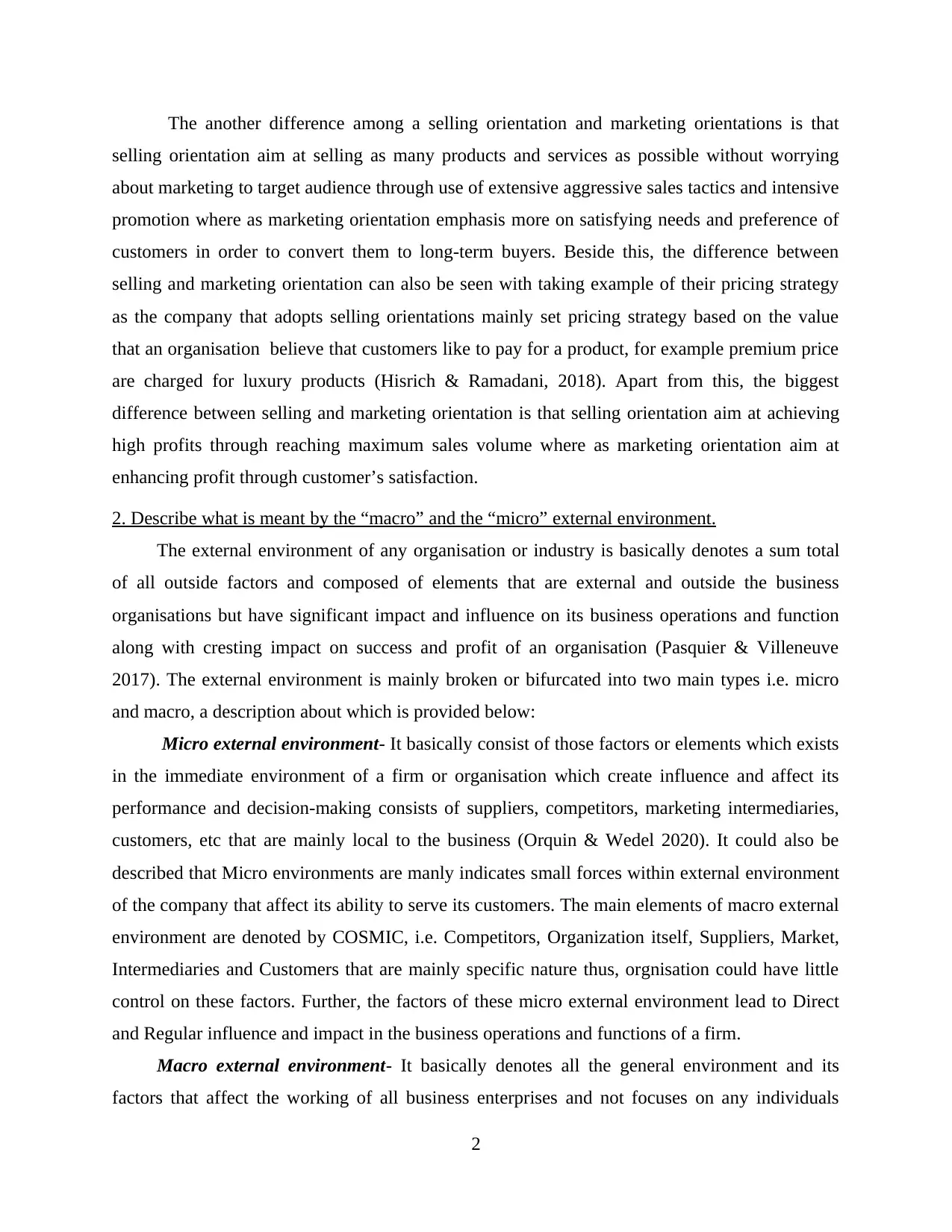
The another difference among a selling orientation and marketing orientations is that
selling orientation aim at selling as many products and services as possible without worrying
about marketing to target audience through use of extensive aggressive sales tactics and intensive
promotion where as marketing orientation emphasis more on satisfying needs and preference of
customers in order to convert them to long-term buyers. Beside this, the difference between
selling and marketing orientation can also be seen with taking example of their pricing strategy
as the company that adopts selling orientations mainly set pricing strategy based on the value
that an organisation believe that customers like to pay for a product, for example premium price
are charged for luxury products (Hisrich & Ramadani, 2018). Apart from this, the biggest
difference between selling and marketing orientation is that selling orientation aim at achieving
high profits through reaching maximum sales volume where as marketing orientation aim at
enhancing profit through customer’s satisfaction.
2. Describe what is meant by the “macro” and the “micro” external environment.
The external environment of any organisation or industry is basically denotes a sum total
of all outside factors and composed of elements that are external and outside the business
organisations but have significant impact and influence on its business operations and function
along with cresting impact on success and profit of an organisation (Pasquier & Villeneuve
2017). The external environment is mainly broken or bifurcated into two main types i.e. micro
and macro, a description about which is provided below:
Micro external environment- It basically consist of those factors or elements which exists
in the immediate environment of a firm or organisation which create influence and affect its
performance and decision-making consists of suppliers, competitors, marketing intermediaries,
customers, etc that are mainly local to the business (Orquin & Wedel 2020). It could also be
described that Micro environments are manly indicates small forces within external environment
of the company that affect its ability to serve its customers. The main elements of macro external
environment are denoted by COSMIC, i.e. Competitors, Organization itself, Suppliers, Market,
Intermediaries and Customers that are mainly specific nature thus, orgnisation could have little
control on these factors. Further, the factors of these micro external environment lead to Direct
and Regular influence and impact in the business operations and functions of a firm.
Macro external environment- It basically denotes all the general environment and its
factors that affect the working of all business enterprises and not focuses on any individuals
2
selling orientation aim at selling as many products and services as possible without worrying
about marketing to target audience through use of extensive aggressive sales tactics and intensive
promotion where as marketing orientation emphasis more on satisfying needs and preference of
customers in order to convert them to long-term buyers. Beside this, the difference between
selling and marketing orientation can also be seen with taking example of their pricing strategy
as the company that adopts selling orientations mainly set pricing strategy based on the value
that an organisation believe that customers like to pay for a product, for example premium price
are charged for luxury products (Hisrich & Ramadani, 2018). Apart from this, the biggest
difference between selling and marketing orientation is that selling orientation aim at achieving
high profits through reaching maximum sales volume where as marketing orientation aim at
enhancing profit through customer’s satisfaction.
2. Describe what is meant by the “macro” and the “micro” external environment.
The external environment of any organisation or industry is basically denotes a sum total
of all outside factors and composed of elements that are external and outside the business
organisations but have significant impact and influence on its business operations and function
along with cresting impact on success and profit of an organisation (Pasquier & Villeneuve
2017). The external environment is mainly broken or bifurcated into two main types i.e. micro
and macro, a description about which is provided below:
Micro external environment- It basically consist of those factors or elements which exists
in the immediate environment of a firm or organisation which create influence and affect its
performance and decision-making consists of suppliers, competitors, marketing intermediaries,
customers, etc that are mainly local to the business (Orquin & Wedel 2020). It could also be
described that Micro environments are manly indicates small forces within external environment
of the company that affect its ability to serve its customers. The main elements of macro external
environment are denoted by COSMIC, i.e. Competitors, Organization itself, Suppliers, Market,
Intermediaries and Customers that are mainly specific nature thus, orgnisation could have little
control on these factors. Further, the factors of these micro external environment lead to Direct
and Regular influence and impact in the business operations and functions of a firm.
Macro external environment- It basically denotes all the general environment and its
factors that affect the working of all business enterprises and not focuses on any individuals
2
Paraphrase This Document
Need a fresh take? Get an instant paraphrase of this document with our AI Paraphraser
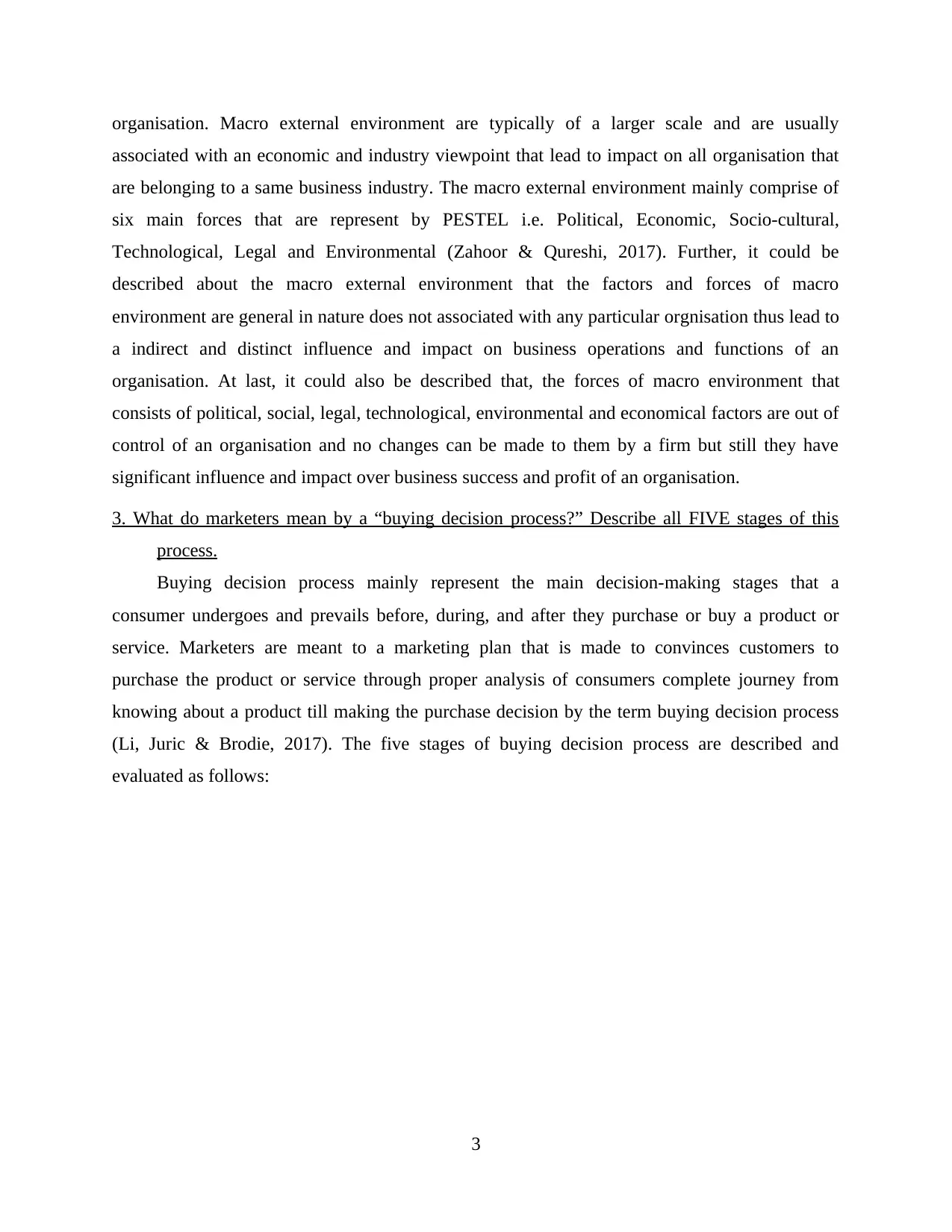
organisation. Macro external environment are typically of a larger scale and are usually
associated with an economic and industry viewpoint that lead to impact on all organisation that
are belonging to a same business industry. The macro external environment mainly comprise of
six main forces that are represent by PESTEL i.e. Political, Economic, Socio-cultural,
Technological, Legal and Environmental (Zahoor & Qureshi, 2017). Further, it could be
described about the macro external environment that the factors and forces of macro
environment are general in nature does not associated with any particular orgnisation thus lead to
a indirect and distinct influence and impact on business operations and functions of an
organisation. At last, it could also be described that, the forces of macro environment that
consists of political, social, legal, technological, environmental and economical factors are out of
control of an organisation and no changes can be made to them by a firm but still they have
significant influence and impact over business success and profit of an organisation.
3. What do marketers mean by a “buying decision process?” Describe all FIVE stages of this
process.
Buying decision process mainly represent the main decision-making stages that a
consumer undergoes and prevails before, during, and after they purchase or buy a product or
service. Marketers are meant to a marketing plan that is made to convinces customers to
purchase the product or service through proper analysis of consumers complete journey from
knowing about a product till making the purchase decision by the term buying decision process
(Li, Juric & Brodie, 2017). The five stages of buying decision process are described and
evaluated as follows:
3
associated with an economic and industry viewpoint that lead to impact on all organisation that
are belonging to a same business industry. The macro external environment mainly comprise of
six main forces that are represent by PESTEL i.e. Political, Economic, Socio-cultural,
Technological, Legal and Environmental (Zahoor & Qureshi, 2017). Further, it could be
described about the macro external environment that the factors and forces of macro
environment are general in nature does not associated with any particular orgnisation thus lead to
a indirect and distinct influence and impact on business operations and functions of an
organisation. At last, it could also be described that, the forces of macro environment that
consists of political, social, legal, technological, environmental and economical factors are out of
control of an organisation and no changes can be made to them by a firm but still they have
significant influence and impact over business success and profit of an organisation.
3. What do marketers mean by a “buying decision process?” Describe all FIVE stages of this
process.
Buying decision process mainly represent the main decision-making stages that a
consumer undergoes and prevails before, during, and after they purchase or buy a product or
service. Marketers are meant to a marketing plan that is made to convinces customers to
purchase the product or service through proper analysis of consumers complete journey from
knowing about a product till making the purchase decision by the term buying decision process
(Li, Juric & Brodie, 2017). The five stages of buying decision process are described and
evaluated as follows:
3
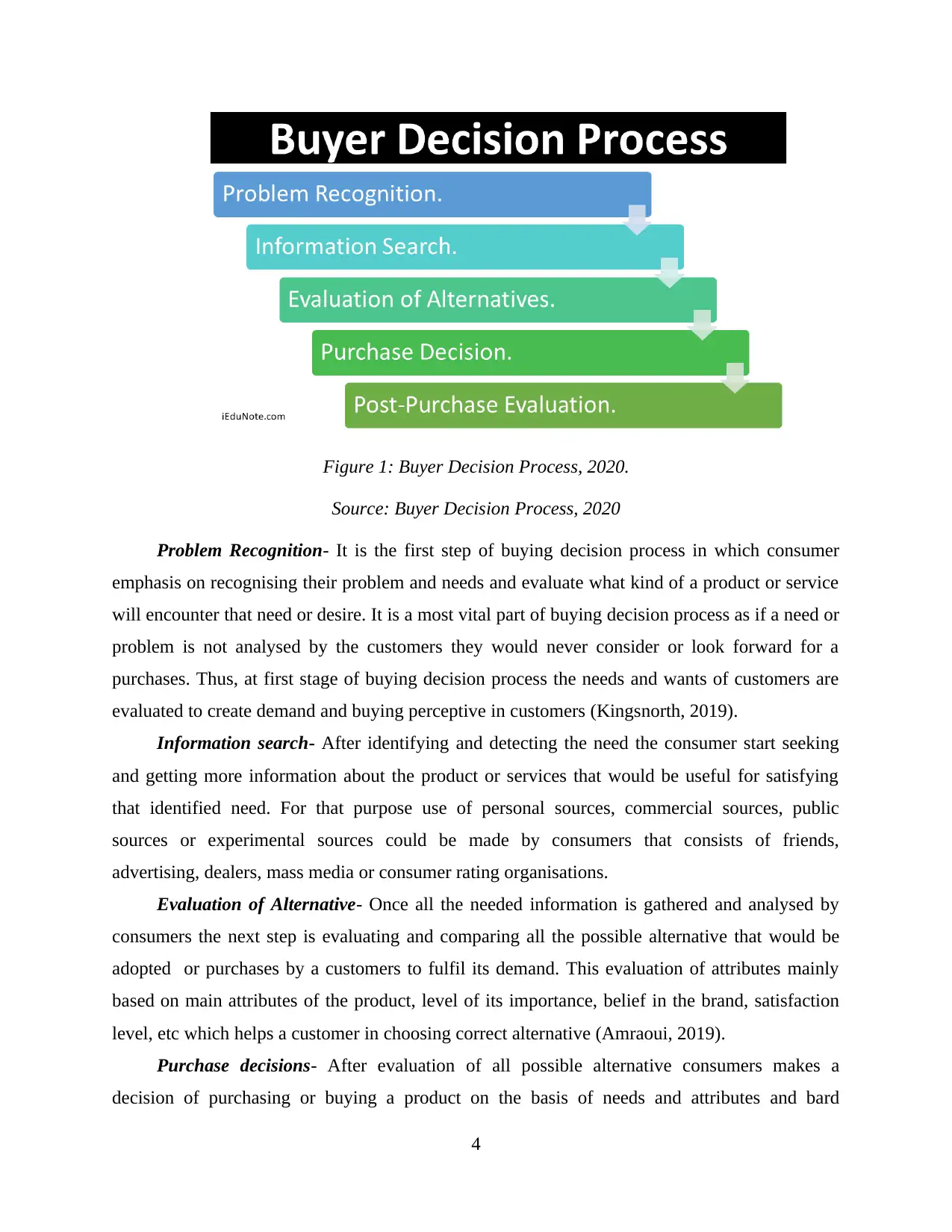
Figure 1: Buyer Decision Process, 2020.
Source: Buyer Decision Process, 2020
Problem Recognition- It is the first step of buying decision process in which consumer
emphasis on recognising their problem and needs and evaluate what kind of a product or service
will encounter that need or desire. It is a most vital part of buying decision process as if a need or
problem is not analysed by the customers they would never consider or look forward for a
purchases. Thus, at first stage of buying decision process the needs and wants of customers are
evaluated to create demand and buying perceptive in customers (Kingsnorth, 2019).
Information search- After identifying and detecting the need the consumer start seeking
and getting more information about the product or services that would be useful for satisfying
that identified need. For that purpose use of personal sources, commercial sources, public
sources or experimental sources could be made by consumers that consists of friends,
advertising, dealers, mass media or consumer rating organisations.
Evaluation of Alternative- Once all the needed information is gathered and analysed by
consumers the next step is evaluating and comparing all the possible alternative that would be
adopted or purchases by a customers to fulfil its demand. This evaluation of attributes mainly
based on main attributes of the product, level of its importance, belief in the brand, satisfaction
level, etc which helps a customer in choosing correct alternative (Amraoui, 2019).
Purchase decisions- After evaluation of all possible alternative consumers makes a
decision of purchasing or buying a product on the basis of needs and attributes and bard
4
Source: Buyer Decision Process, 2020
Problem Recognition- It is the first step of buying decision process in which consumer
emphasis on recognising their problem and needs and evaluate what kind of a product or service
will encounter that need or desire. It is a most vital part of buying decision process as if a need or
problem is not analysed by the customers they would never consider or look forward for a
purchases. Thus, at first stage of buying decision process the needs and wants of customers are
evaluated to create demand and buying perceptive in customers (Kingsnorth, 2019).
Information search- After identifying and detecting the need the consumer start seeking
and getting more information about the product or services that would be useful for satisfying
that identified need. For that purpose use of personal sources, commercial sources, public
sources or experimental sources could be made by consumers that consists of friends,
advertising, dealers, mass media or consumer rating organisations.
Evaluation of Alternative- Once all the needed information is gathered and analysed by
consumers the next step is evaluating and comparing all the possible alternative that would be
adopted or purchases by a customers to fulfil its demand. This evaluation of attributes mainly
based on main attributes of the product, level of its importance, belief in the brand, satisfaction
level, etc which helps a customer in choosing correct alternative (Amraoui, 2019).
Purchase decisions- After evaluation of all possible alternative consumers makes a
decision of purchasing or buying a product on the basis of needs and attributes and bard
4
⊘ This is a preview!⊘
Do you want full access?
Subscribe today to unlock all pages.

Trusted by 1+ million students worldwide
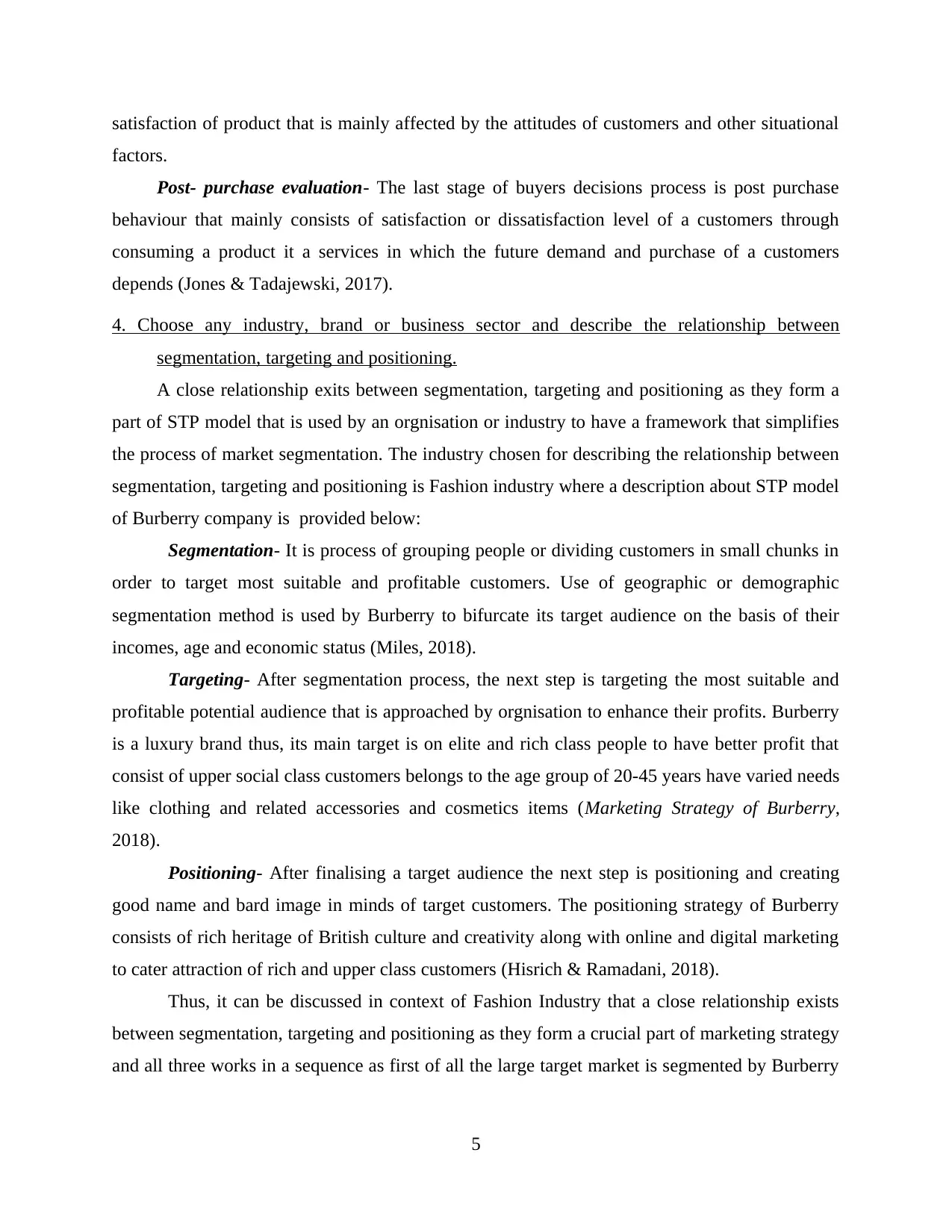
satisfaction of product that is mainly affected by the attitudes of customers and other situational
factors.
Post- purchase evaluation- The last stage of buyers decisions process is post purchase
behaviour that mainly consists of satisfaction or dissatisfaction level of a customers through
consuming a product it a services in which the future demand and purchase of a customers
depends (Jones & Tadajewski, 2017).
4. Choose any industry, brand or business sector and describe the relationship between
segmentation, targeting and positioning.
A close relationship exits between segmentation, targeting and positioning as they form a
part of STP model that is used by an orgnisation or industry to have a framework that simplifies
the process of market segmentation. The industry chosen for describing the relationship between
segmentation, targeting and positioning is Fashion industry where a description about STP model
of Burberry company is provided below:
Segmentation- It is process of grouping people or dividing customers in small chunks in
order to target most suitable and profitable customers. Use of geographic or demographic
segmentation method is used by Burberry to bifurcate its target audience on the basis of their
incomes, age and economic status (Miles, 2018).
Targeting- After segmentation process, the next step is targeting the most suitable and
profitable potential audience that is approached by orgnisation to enhance their profits. Burberry
is a luxury brand thus, its main target is on elite and rich class people to have better profit that
consist of upper social class customers belongs to the age group of 20-45 years have varied needs
like clothing and related accessories and cosmetics items (Marketing Strategy of Burberry,
2018).
Positioning- After finalising a target audience the next step is positioning and creating
good name and bard image in minds of target customers. The positioning strategy of Burberry
consists of rich heritage of British culture and creativity along with online and digital marketing
to cater attraction of rich and upper class customers (Hisrich & Ramadani, 2018).
Thus, it can be discussed in context of Fashion Industry that a close relationship exists
between segmentation, targeting and positioning as they form a crucial part of marketing strategy
and all three works in a sequence as first of all the large target market is segmented by Burberry
5
factors.
Post- purchase evaluation- The last stage of buyers decisions process is post purchase
behaviour that mainly consists of satisfaction or dissatisfaction level of a customers through
consuming a product it a services in which the future demand and purchase of a customers
depends (Jones & Tadajewski, 2017).
4. Choose any industry, brand or business sector and describe the relationship between
segmentation, targeting and positioning.
A close relationship exits between segmentation, targeting and positioning as they form a
part of STP model that is used by an orgnisation or industry to have a framework that simplifies
the process of market segmentation. The industry chosen for describing the relationship between
segmentation, targeting and positioning is Fashion industry where a description about STP model
of Burberry company is provided below:
Segmentation- It is process of grouping people or dividing customers in small chunks in
order to target most suitable and profitable customers. Use of geographic or demographic
segmentation method is used by Burberry to bifurcate its target audience on the basis of their
incomes, age and economic status (Miles, 2018).
Targeting- After segmentation process, the next step is targeting the most suitable and
profitable potential audience that is approached by orgnisation to enhance their profits. Burberry
is a luxury brand thus, its main target is on elite and rich class people to have better profit that
consist of upper social class customers belongs to the age group of 20-45 years have varied needs
like clothing and related accessories and cosmetics items (Marketing Strategy of Burberry,
2018).
Positioning- After finalising a target audience the next step is positioning and creating
good name and bard image in minds of target customers. The positioning strategy of Burberry
consists of rich heritage of British culture and creativity along with online and digital marketing
to cater attraction of rich and upper class customers (Hisrich & Ramadani, 2018).
Thus, it can be discussed in context of Fashion Industry that a close relationship exists
between segmentation, targeting and positioning as they form a crucial part of marketing strategy
and all three works in a sequence as first of all the large target market is segmented by Burberry
5
Paraphrase This Document
Need a fresh take? Get an instant paraphrase of this document with our AI Paraphraser
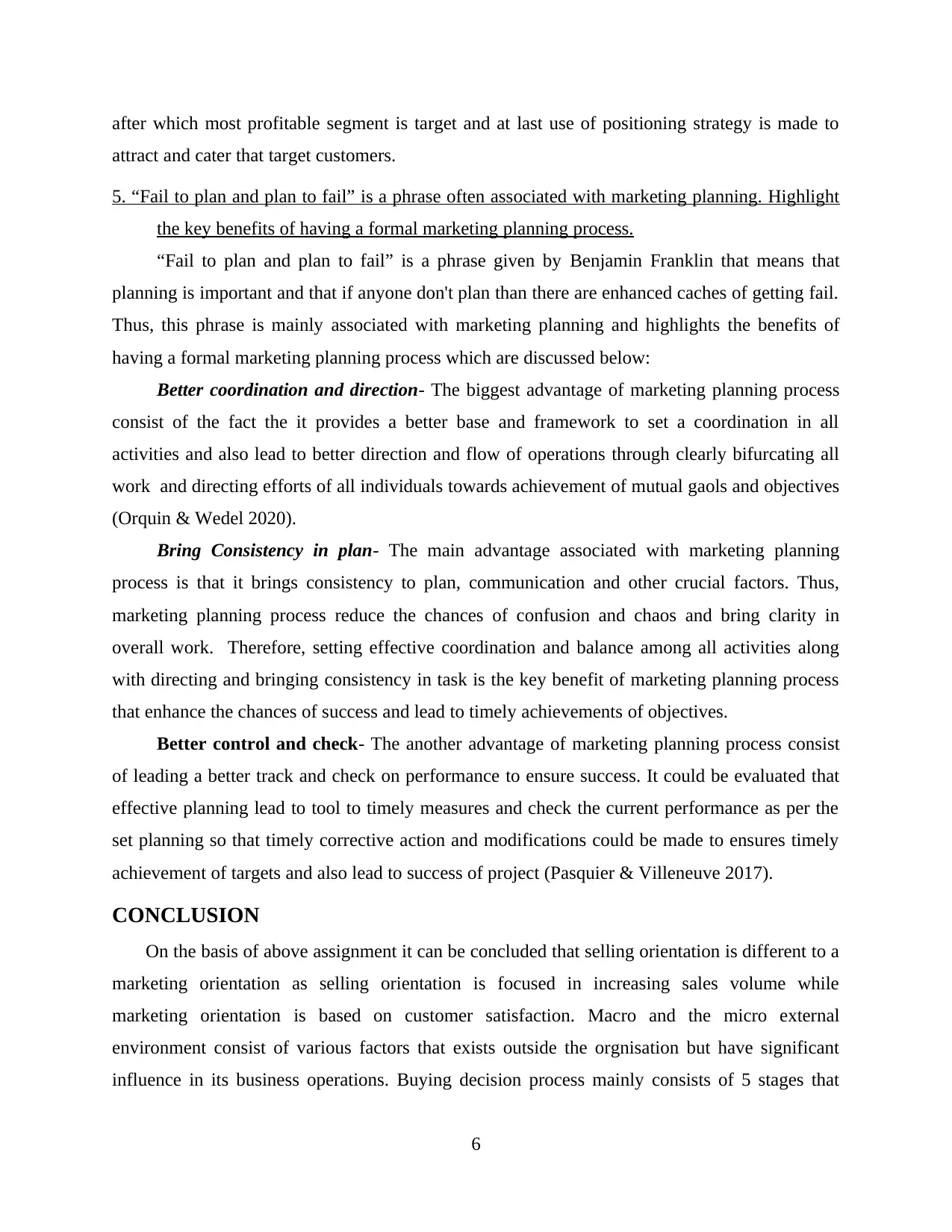
after which most profitable segment is target and at last use of positioning strategy is made to
attract and cater that target customers.
5. “Fail to plan and plan to fail” is a phrase often associated with marketing planning. Highlight
the key benefits of having a formal marketing planning process.
“Fail to plan and plan to fail” is a phrase given by Benjamin Franklin that means that
planning is important and that if anyone don't plan than there are enhanced caches of getting fail.
Thus, this phrase is mainly associated with marketing planning and highlights the benefits of
having a formal marketing planning process which are discussed below:
Better coordination and direction- The biggest advantage of marketing planning process
consist of the fact the it provides a better base and framework to set a coordination in all
activities and also lead to better direction and flow of operations through clearly bifurcating all
work and directing efforts of all individuals towards achievement of mutual gaols and objectives
(Orquin & Wedel 2020).
Bring Consistency in plan- The main advantage associated with marketing planning
process is that it brings consistency to plan, communication and other crucial factors. Thus,
marketing planning process reduce the chances of confusion and chaos and bring clarity in
overall work. Therefore, setting effective coordination and balance among all activities along
with directing and bringing consistency in task is the key benefit of marketing planning process
that enhance the chances of success and lead to timely achievements of objectives.
Better control and check- The another advantage of marketing planning process consist
of leading a better track and check on performance to ensure success. It could be evaluated that
effective planning lead to tool to timely measures and check the current performance as per the
set planning so that timely corrective action and modifications could be made to ensures timely
achievement of targets and also lead to success of project (Pasquier & Villeneuve 2017).
CONCLUSION
On the basis of above assignment it can be concluded that selling orientation is different to a
marketing orientation as selling orientation is focused in increasing sales volume while
marketing orientation is based on customer satisfaction. Macro and the micro external
environment consist of various factors that exists outside the orgnisation but have significant
influence in its business operations. Buying decision process mainly consists of 5 stages that
6
attract and cater that target customers.
5. “Fail to plan and plan to fail” is a phrase often associated with marketing planning. Highlight
the key benefits of having a formal marketing planning process.
“Fail to plan and plan to fail” is a phrase given by Benjamin Franklin that means that
planning is important and that if anyone don't plan than there are enhanced caches of getting fail.
Thus, this phrase is mainly associated with marketing planning and highlights the benefits of
having a formal marketing planning process which are discussed below:
Better coordination and direction- The biggest advantage of marketing planning process
consist of the fact the it provides a better base and framework to set a coordination in all
activities and also lead to better direction and flow of operations through clearly bifurcating all
work and directing efforts of all individuals towards achievement of mutual gaols and objectives
(Orquin & Wedel 2020).
Bring Consistency in plan- The main advantage associated with marketing planning
process is that it brings consistency to plan, communication and other crucial factors. Thus,
marketing planning process reduce the chances of confusion and chaos and bring clarity in
overall work. Therefore, setting effective coordination and balance among all activities along
with directing and bringing consistency in task is the key benefit of marketing planning process
that enhance the chances of success and lead to timely achievements of objectives.
Better control and check- The another advantage of marketing planning process consist
of leading a better track and check on performance to ensure success. It could be evaluated that
effective planning lead to tool to timely measures and check the current performance as per the
set planning so that timely corrective action and modifications could be made to ensures timely
achievement of targets and also lead to success of project (Pasquier & Villeneuve 2017).
CONCLUSION
On the basis of above assignment it can be concluded that selling orientation is different to a
marketing orientation as selling orientation is focused in increasing sales volume while
marketing orientation is based on customer satisfaction. Macro and the micro external
environment consist of various factors that exists outside the orgnisation but have significant
influence in its business operations. Buying decision process mainly consists of 5 stages that
6
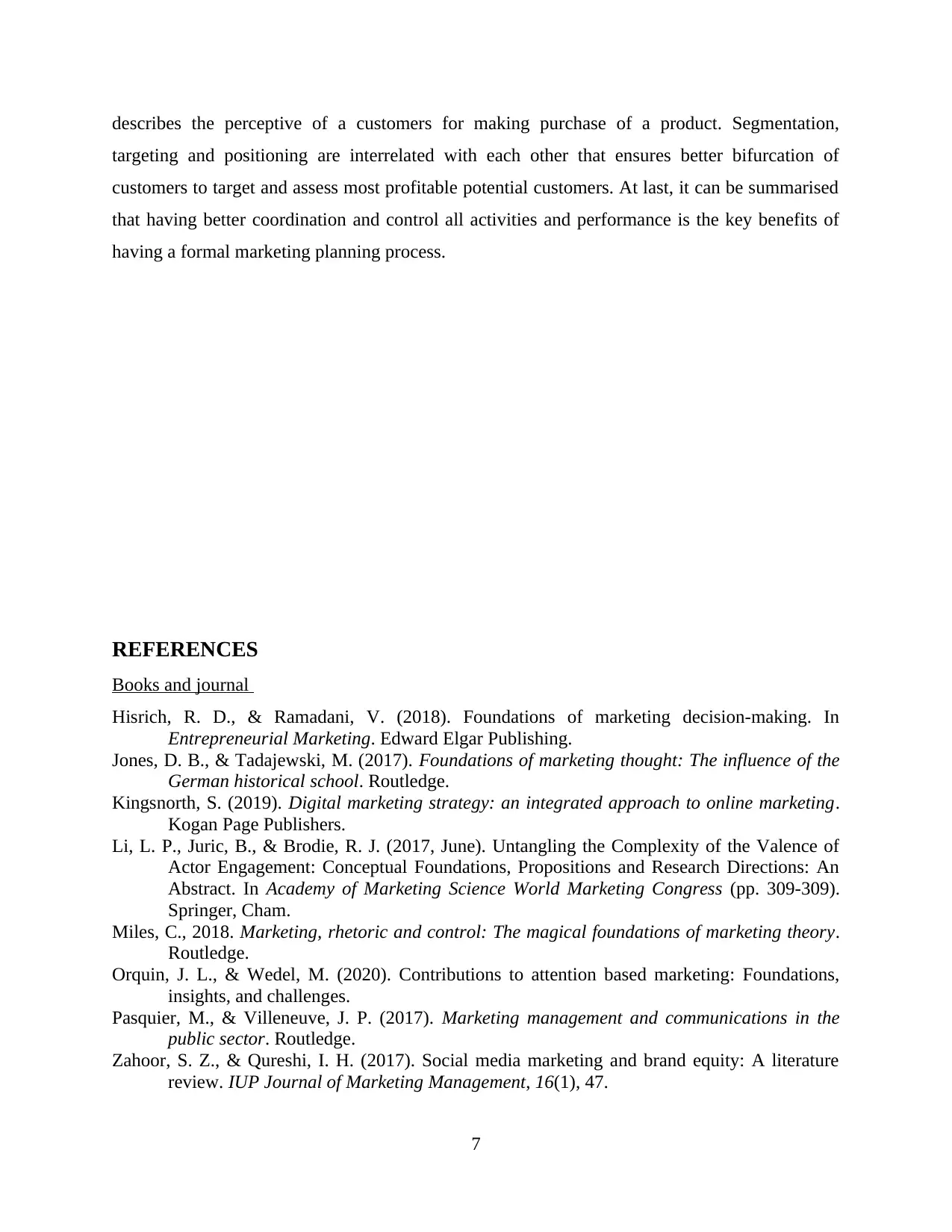
describes the perceptive of a customers for making purchase of a product. Segmentation,
targeting and positioning are interrelated with each other that ensures better bifurcation of
customers to target and assess most profitable potential customers. At last, it can be summarised
that having better coordination and control all activities and performance is the key benefits of
having a formal marketing planning process.
REFERENCES
Books and journal
Hisrich, R. D., & Ramadani, V. (2018). Foundations of marketing decision-making. In
Entrepreneurial Marketing. Edward Elgar Publishing.
Jones, D. B., & Tadajewski, M. (2017). Foundations of marketing thought: The influence of the
German historical school. Routledge.
Kingsnorth, S. (2019). Digital marketing strategy: an integrated approach to online marketing.
Kogan Page Publishers.
Li, L. P., Juric, B., & Brodie, R. J. (2017, June). Untangling the Complexity of the Valence of
Actor Engagement: Conceptual Foundations, Propositions and Research Directions: An
Abstract. In Academy of Marketing Science World Marketing Congress (pp. 309-309).
Springer, Cham.
Miles, C., 2018. Marketing, rhetoric and control: The magical foundations of marketing theory.
Routledge.
Orquin, J. L., & Wedel, M. (2020). Contributions to attention based marketing: Foundations,
insights, and challenges.
Pasquier, M., & Villeneuve, J. P. (2017). Marketing management and communications in the
public sector. Routledge.
Zahoor, S. Z., & Qureshi, I. H. (2017). Social media marketing and brand equity: A literature
review. IUP Journal of Marketing Management, 16(1), 47.
7
targeting and positioning are interrelated with each other that ensures better bifurcation of
customers to target and assess most profitable potential customers. At last, it can be summarised
that having better coordination and control all activities and performance is the key benefits of
having a formal marketing planning process.
REFERENCES
Books and journal
Hisrich, R. D., & Ramadani, V. (2018). Foundations of marketing decision-making. In
Entrepreneurial Marketing. Edward Elgar Publishing.
Jones, D. B., & Tadajewski, M. (2017). Foundations of marketing thought: The influence of the
German historical school. Routledge.
Kingsnorth, S. (2019). Digital marketing strategy: an integrated approach to online marketing.
Kogan Page Publishers.
Li, L. P., Juric, B., & Brodie, R. J. (2017, June). Untangling the Complexity of the Valence of
Actor Engagement: Conceptual Foundations, Propositions and Research Directions: An
Abstract. In Academy of Marketing Science World Marketing Congress (pp. 309-309).
Springer, Cham.
Miles, C., 2018. Marketing, rhetoric and control: The magical foundations of marketing theory.
Routledge.
Orquin, J. L., & Wedel, M. (2020). Contributions to attention based marketing: Foundations,
insights, and challenges.
Pasquier, M., & Villeneuve, J. P. (2017). Marketing management and communications in the
public sector. Routledge.
Zahoor, S. Z., & Qureshi, I. H. (2017). Social media marketing and brand equity: A literature
review. IUP Journal of Marketing Management, 16(1), 47.
7
⊘ This is a preview!⊘
Do you want full access?
Subscribe today to unlock all pages.

Trusted by 1+ million students worldwide
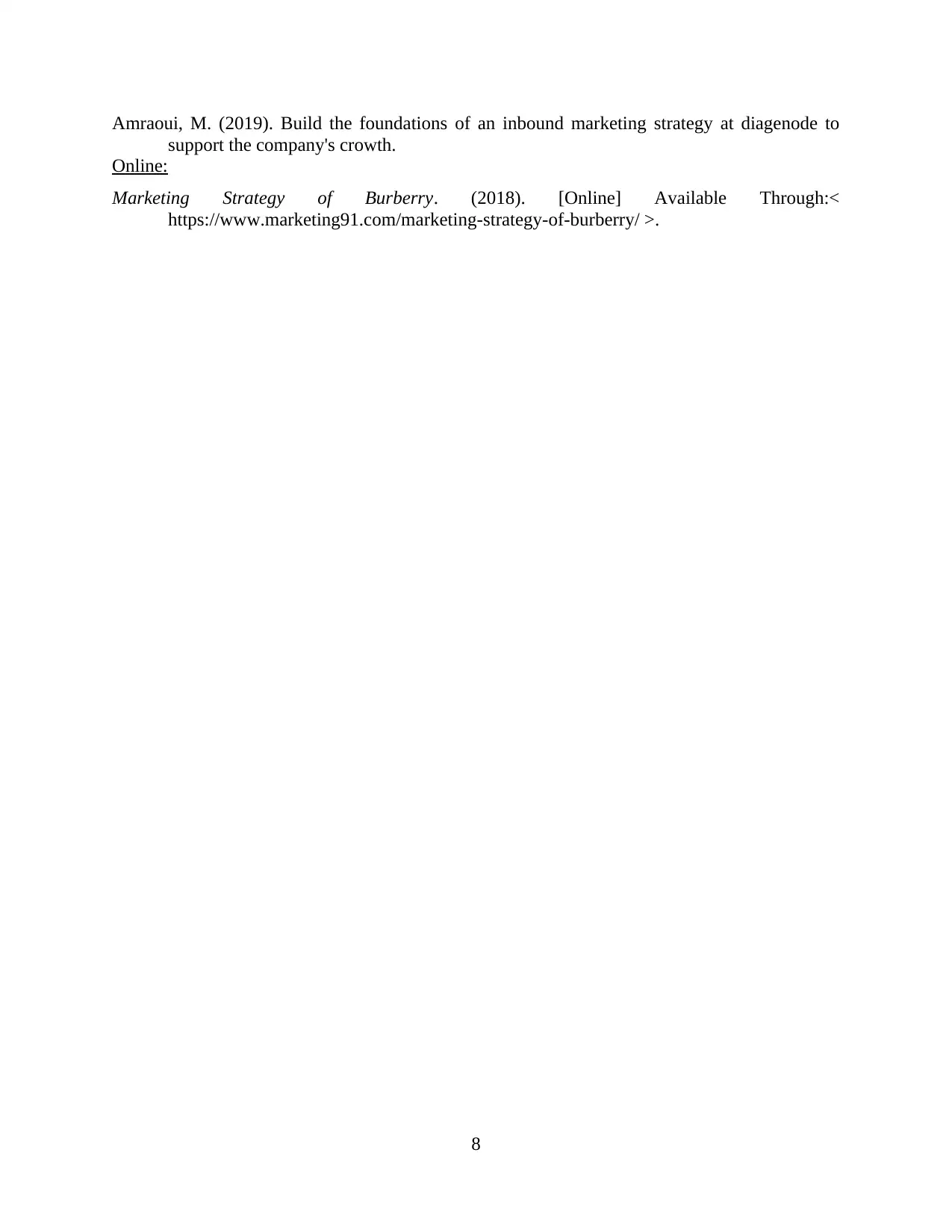
Amraoui, M. (2019). Build the foundations of an inbound marketing strategy at diagenode to
support the company's crowth.
Online:
Marketing Strategy of Burberry. (2018). [Online] Available Through:<
https://www.marketing91.com/marketing-strategy-of-burberry/ >.
8
support the company's crowth.
Online:
Marketing Strategy of Burberry. (2018). [Online] Available Through:<
https://www.marketing91.com/marketing-strategy-of-burberry/ >.
8
1 out of 10
Related Documents
Your All-in-One AI-Powered Toolkit for Academic Success.
+13062052269
info@desklib.com
Available 24*7 on WhatsApp / Email
![[object Object]](/_next/static/media/star-bottom.7253800d.svg)
Unlock your academic potential
Copyright © 2020–2025 A2Z Services. All Rights Reserved. Developed and managed by ZUCOL.





